动物隐喻的认知研究_
- 格式:pdf
- 大小:177.83 KB
- 文档页数:3
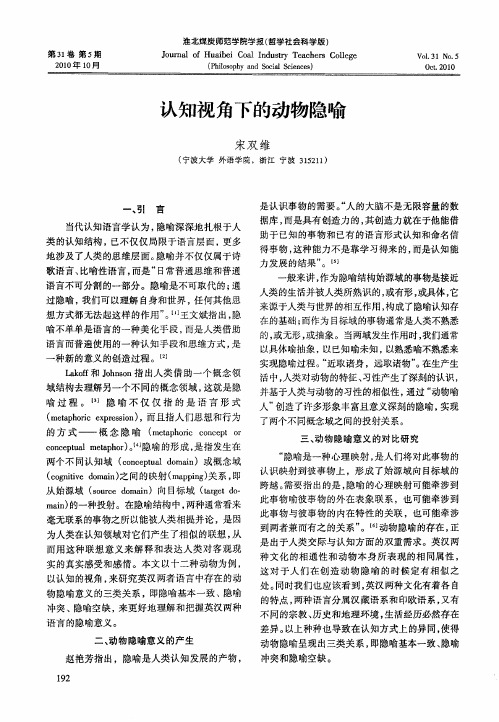
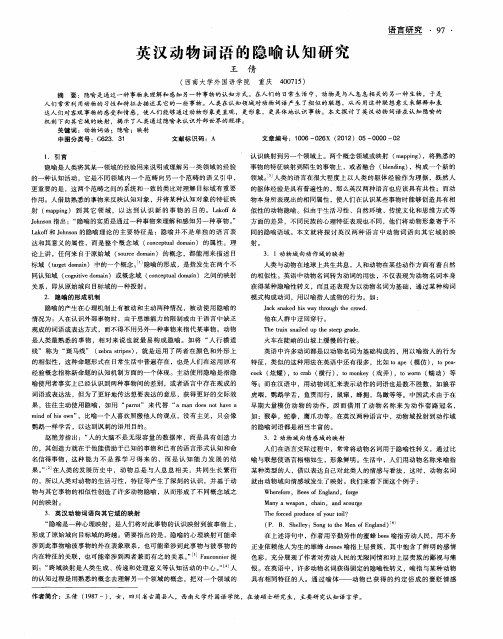

牡丹《动物园的故事》中的动物隐喻认知分析外国文学鉴赏WAI GUO WEN XUE JIAN SHANG·52·两个女儿和……呃……一条狗?(彼得摇头)不对?两条狗?(彼得又摇头)。
没狗?(彼得伤心地摇头)啊,太不像话”。
一开始Jerry了解到了Peter没有儿子,所以当Jerry猜测彼得家养有宠物狗时,Peter只能无奈地摇头,正如他说“事实上,每个男人都想要一只狗”时充满无奈。
很显然,当Peter说出每个男人都想要一个儿子时,他是无奈而渴求的。
由于和妻子女儿的关系不是非常融洽,他只能选择每周末下午到公园的长凳上通过阅读来解闷。
实际上,在那样一个高度工业化的社会里,人与人之间普遍缺乏真心的交流与关爱,所以主人公Peter很渴望有个儿子能与他作伴,与他交流玩耍,分担快乐与忧愁。
Jerry猜测Peter家里会养狗,言外之意就是认为既然Peter没有儿子,那么总得养几只狗解闷作伴。
英语中狗除指一般的狗外,还可以指公狗、公狼、家伙等,所以这里的狗隐喻的是“儿子”。
作者阿尔比一再强调在那样一个荒诞的社会,动物狗可以直接作为人类的儿子,与人交流,消除人们孤离落寞的心患。
而人类却缺失了这一角色的扮演权,人与人之间剩下的仅是孤离、冷漠、悲哀。
阿尔比表面意图将狗视于人类的儿子,实际上是对人类关系的一种讽刺。
在那个利益量化、到处充满竞争的社会,人与人的真心交流与和谐相处已变得奢侈,甚至是可望而不可求,唯有把自己变得渺小简单,并囚禁于动物般的牢笼世界里,与心爱的饲养动物狗进行交流为伴,人们方可得以平衡、欣慰与快乐。
(二)猫和鹦鹉正如Jerry所说,Peter是个喜爱动物的人,尤其是狗。
但当Jerry问及Peter家里是否有猫时,Peter懊丧地点点头,并表明养猫是她老婆和女儿的主意。
另外,Peter还道明了她的两个女儿各自养了一只长尾小鹦鹉与她们作伴。
首先,在家庭里,Peter无法与她的妻子女儿和谐快乐地相处,为此他渴望养育一条狗与他交流为伴。
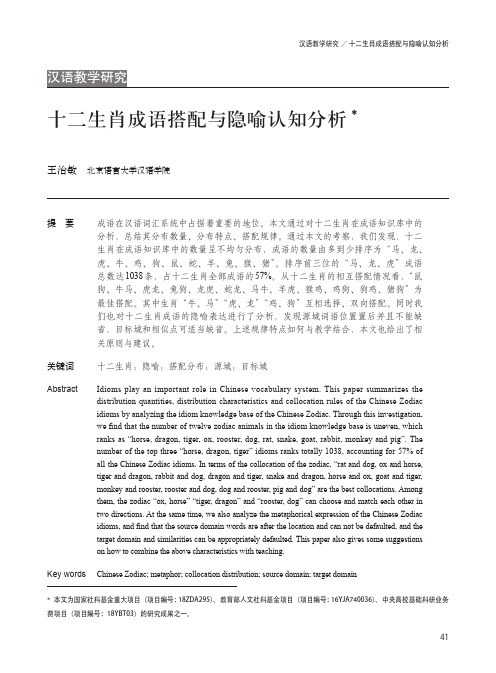
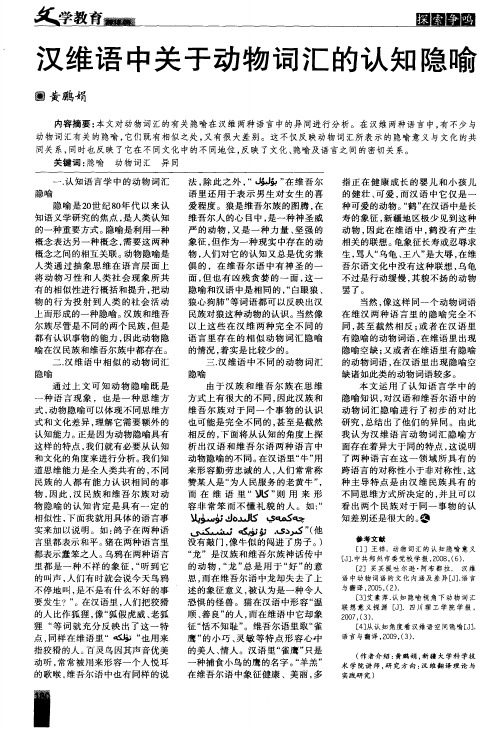
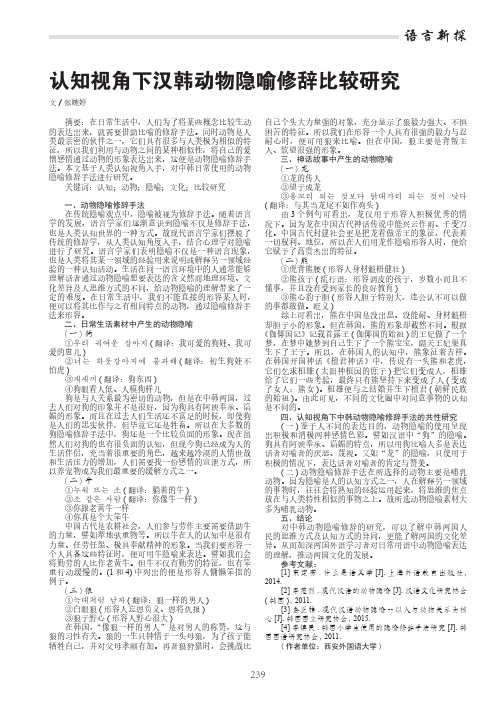
语言新探认知视角下汉韩动物隐喻修辞比较研究文/张婉婷摘要:在日常生活中,人们为了将某些概念比较生动的表达出来,就需要借助比喻的修辞手法。
同时动物是人类最亲密的伙伴之一,它们具有很多与人类极为相似的特征,所以我们利用与动物之间的某种相似性,将自己的爱憎感情通过动物的形象表达出来,这便是动物隐喻修辞手法。
本文基于人类认知视角入手,对中韩日常使用的动物隐喻修辞手法进行研究。
关键词:认知;动物;隐喻;文化;比较研究一、动物隐喻修辞手法在传统隐喻观点中,隐喻被视为修辞手法。
随着语言学的发展,语言学家们逐渐意识到隐喻不仅是修辞手法,也是人类认知世界的一种方式。
故现代语言学家们摆脱了传统的修辞学,从人类认知角度入手,结合心理学对隐喻进行了研究。
语言学家们表明隐喻不仅是一种语言现象,也是人类将其某一领域的经验用来说明或解释另一领域经验的一种认知活动。
生活在同一语言环境中的人通常能够理解话者通过动物隐喻想要表达的含义然而地理环境、文化差异及人思维方式的不同,给动物隐喻的理解带来了一定的难度。
在日常生活中,我们不能直接的形容某人时,便可以将其比作与之有相同特点的动物,通过隐喻修辞手法来形容。
二、日常生活素材中产生的动物隐喻(一)狗①우리 궈여운 강아지(翻译:我可爱的狗娃、我可爱的崽儿)②너는 하룻강아지에 불과해(翻译:初生狗娃不怕虎)③개새끼(翻译:狗东西)④狗眼看人低、人模狗样儿狗是与人关系最为密切的动物,但是在中韩两国,过去人们对狗的印象并不是很好,因为狗具有阿谀奉承、谄媚的形象。
而且在过去人们生活还不富足的时候,即使狗是人们的忠实伙伴,但毕竟它还是牲畜。
所以在大多数的狗隐喻修辞手法中,狗还是一个比较负面的形象。
现在虽然人们对狗的也有很负面的认知,但现今狗已经成为人的生活伴侣,充当着很重要的角色,越来越冷漠的人情世故和生活压力的增加,人们需要找一份感情的宣泄方式,所以养宠物成为我们最重要的缓解方式之一。
(二)牛①누워 뜨는 소(翻译:躺着的牛)②소 같은 사람(翻译:你像牛一样)③你跟老黄牛一样④你真是个大笨牛中国古代是农耕社会,人们参与劳作主要需要借助牛的力量,譬如犁地驮重物等。
郑州师范学院毕业论文题目动物习语的隐喻认知研究姓名王旭初学号114104053019院系外国语学院专业英语年级班级B11英语3班指导教师赵海峰2015年5月6日毕业论文作者声明本人郑重声明:所呈交的毕业论文是本人在导师的指导下独立进行研究所取得的研究成果。
除了文中特别加以标注引用的内容外,本论文不包含任何其他个人或集体已经发表或撰写的成果作品。
本人完全了解有关保障、使用毕业论文的规定,同意学校保留并向有关毕业论文管理机构送交论文的复印件和电子版。
同意省级优秀毕业论文评选机构将本毕业论文通过影印、缩印、扫描等方式进行保存、摘编或汇编;同意本论文被编入有关数据库进行检索和查阅。
本毕业论文内容不涉及国家机密。
论文题目:动物习语的隐喻认知研究作者单位:郑州师范学院外国语学院2011级3班作者签名:2015年5月6日A Cognitive Analysis of Animal Idiomsfrom the Perspective of MetaphorSubmitted by Wang XuchuStudent ID number 114104053019Supervised by Zhao HaifengA paper submitted in fulfillment of the requirements ofthe degree of Bachelor of ArtsForeign Languages SchoolZhengzhou Normal UniversityMay, 2015Contents摘要 (i)Abstract ...................................................................................................................... i i Ⅰ. Introduction . (1)1.1 Background and Significance of the Study (1)1.2 Organization of the Thesis (3)Ⅱ. Literature Review (4)2.1 The Study of Metaphor (4)2.2 The Study of Idiom (7)2.3 Conclusion of Previous Research (8)Ⅲ. Theoretical Framework and Methodology (8)3.1 Cognitive Views on Metaphor (8)3.2 Methodology (11)3.2.1 The Definition of Idioms (11)3.2.2 Data Collection (12)Ⅳ. An Analysis of Animal Idioms from the Perspective of Metaphor12 4.1 Bear (13)4.2 Bull (13)4.3 Cat (14)4.4 Dog (16)4.5 Hare (17)4.6 Mouse (17)4.7 Pig (18)4.8 Sheep (18)4.9 Wolf (19)Ⅴ. Findings and Discussion (19)Ⅵ. Conclusion (20)Bibliography (23)Acknowledgments (26)Appendix (27)动物习语的隐喻认知研究摘要莱考夫和约翰逊认为我们赖以思考和行动的日常概念系统,在本质上是隐喻性的。
认知隐喻学视角下东北方言中的动物隐喻研究作者:滕宇来源:《青年时代》2018年第20期摘要:上世纪八十年代,隐喻研究由修辞手段转向认知方式,而近年来,隐喻研究呈多样化趋势。
本文通过对东北方言中的动物隐喻现象进行盘点和分析,来剖析其深层次的语言规律和民族文化特征,既探究了动物隐喻的认知模式,又展示了东北方言幽默诙谐、生动形象的语言特色。
关键词:认知隐喻学;动物隐喻;东北方言一、引言隐喻是人类认识世界的一种重要方式,这种认知模式让语言使用者借助已知事物来理解、描绘未知事物,从而产生新的概念范畴,新的语义认知。
在各种隐喻词汇中,人体词、植物词和动物词都占有很大的比例。
古往今来,动物在人类的生产、生活当中扮演着极为重要的角色,朝夕相处之下人们对许多动物的特征和习性有着较为深刻地了解,随着人们发现动物与人类活动存在的诸多相似之处,动物隐喻也在人类语言中占据越來越重要地位。
迄今为止,虽然学界对于隐喻的研究十分多见,但对于动物隐喻的研究却尚不充分,而且大多数现有研究主要集中在英汉动物隐喻的文化对照(廖光蓉,2000;詹蓓,2003)[1][2]、文学分析(李巧慧,2004;胡家峦,2006)[3][4]等领域,尚无学者以东北方言为语料来研究动物隐喻。
中华民族传统文化博大精深,东北文化是传统文化的重要支脉。
“东北文化在历史的积淀和社会意识的潜流中形成了同心同德、顾全大局的精神,并且成为东北人的一种精神家园”[5]。
语言是文化的重要组成部分,文化亦在很大程度上影响着语言的产出。
方言是某地区人们共同使用的语言,是地域文化的载体。
东北方言受地区自然环境和人文环境的影响,有其独特的语言特色。
二、隐喻的工作机制传统观念认为,隐喻只是语言形式上的一种修辞形式,亚里士多德曾提出“隐喻可以对语言起到装饰作用,它可以使语言更加丰富多彩”[6]。
这种观念主要强调隐喻的美学功能,强调隐喻是存在于正常语言之外并需要特殊理解的修辞手段,是一种附加的、可有可无的修饰物。
阿拉伯语动物相关熟语的隐喻认知研究阿拉伯语动物相关熟语的隐喻认知研究引言:隐喻是一种常见的修辞手法,通过借用一个事物的名称或形象来暗示另一个事物的含义。
熟语是一种常见的语言现象,是人们长期积累的经验和智慧的结晶。
阿拉伯语中也存在许多动物相关的熟语,这些熟语不仅反映了阿拉伯文化中对动物的认知,同时也展现出人们对动物所赋予的隐喻含义。
本文将探讨阿拉伯语动物相关熟语的隐喻认知,并分析其在语言中的应用。
一、熟语背景与来源1.1 阿拉伯语中的动物熟语阿拉伯语是世界上最重要的语言之一,拥有丰富的文化内涵。
在阿拉伯语中,许多动物相关的熟语被广泛使用,如“愤怒的公牛”、“老狐狸”等。
这些熟语既可以在日常交流中使用,也可以在文学作品中找到。
1.2 熟语的来源熟语的形成来源于人们对于事物的认知与感知。
阿拉伯语中的动物熟语以动物的特征和行为为基础,展现出阿拉伯文化中对动物的理解和审视。
二、动物熟语的隐喻含义2.1 公牛的隐喻含义公牛在阿拉伯文化中被视为勇猛、强大的象征。
熟语“愤怒的公牛”常用来形容气急败坏、怒不可遏的人。
这一隐喻含义显示了公牛作为一种动物形象的影响力。
2.2 狐狸的隐喻含义狐狸在阿拉伯文化中被认为是狡猾、机智的象征。
熟语“老狐狸”常用来形容精明、圆滑的人。
这一隐喻暗示了狐狸的聪明才智和灵活性。
2.3 驼鸟的隐喻含义驼鸟在阿拉伯文化中被视为胆怯、怯懦的象征。
熟语“像驼鸟一样躲避”常用来形容逃避现实、回避困难的人。
这一隐喻传达了驼鸟作为一个动物形象所代表的懦弱和逃避。
三、动物熟语的认知功能3.1 概念的延伸与转化通过将动物的特征和行为与人类行为和特征进行类比,动物熟语在阿拉伯语中起到了概念的延伸与转化的作用。
这使得原本抽象或难以描述的概念得以通过具体的动物形象来表达。
3.2 情感与态度的渲染动物熟语在阿拉伯语中常用来渲染情感和态度。
通过使用特定的动物形象,熟语可以快速准确地传达情感,使得文本更加生动和形象化。
动物隐喻的中西对比研究及项目教学一、引言隐喻是一种语言现象,也是一种认知过程,是人类认识世界,积累经验的一种重要方式。
Lakoff (1980)将隐喻看作是人们思维、行为和表达思想的一种系统的方式。
动物隐喻是隐喻的一种,在这个隐喻过程中,人类通过动物的某些特质来进行理解人类的某些特征和行为。
动物隐喻具有文化性。
不同的文化中,动物隐喻的内涵有相同之处,也有相异的地方。
有共通之处是因为人类在获取知识和经验方面具有趋同性。
有相异之处是因为不同的民族有不同的文化背景,宗教背景,风俗习惯等,这些差异会最终导致语言表达的不同。
本文旨在对比分析中西动物隐喻的差异,并探讨了围绕动物隐喻进行的相关教学活动。
二、喻体相同,喻义相似因为人类生活环境及生活经验的相似性,人类对于动物的认知具有相通之处。
因此,中西动物隐喻中有的动物具有类似的隐喻含义。
比如,在英语中,人们会说“ he is a fox ”(他是一只狐狸),形容一个人很狡猾。
在中文中,人们形容一个人诡计多端时,也会说“一只老狐狸”。
这些例子表明在英汉两种语言中,“ fox ”(狐狸)这种动物被赋予了相同的隐喻意义。
另一种动物在英汉两种语言中也有相近的含义,那就是“sheep”或“ lamb”(羊)。
在两种语言中,羊都象征了乖巧温顺的性格特征。
《圣经》里有“ silent lamb” (沉默的羔羊), 而中文中有“待宰的羔羊”,“温顺的小绵羊”的说法。
此外,在中英动物隐喻中还可以看到许多共性的表达,如蜜蜂是勤劳的,小鸟总是与自由联系在一起,而蜗牛总是慢腾腾的,鹦鹉会学舌,天鹅姿态优雅。
三、喻体相同,喻义相异因为中西方在文化传统,生活习俗和宗教信仰等方面存在着巨大的差异,所以在动物隐喻方面两种语言也存在明显的差异。
比如我们都很熟悉的动物“狗”。
在中文和英文中,与“狗”相关的隐喻有着截然相反的喻义。
中文中大部分与“狗”相关的词都是贬义的,如“狗胆包天”,“狗腿子”,“狼心狗肺”,“狗眼看人低”等等。
Chapter 1 IntroductionAnimals play a vital role in the life of human beings. From a biological viewpoint, human beings are a genus of animals. Human beings and animals have a lot in common in terms of gene, physical features, actions, and behaviors, etc. Owing to frequent contact with animals, human beings create many animal words in their languages. Metaphor is pervasive in our everyday life, not only in language, but also in our thought and action. Traditionally or rhetorically, metaphor is regarded as a matter of language, whose typical form is “A is B”, and as an implicit comparison between a metaphorical expression and a literal paraphrase based on underlying analogy or similarity in order to achieve certain aesthetic effect. Take the example “Sam is a lion”, when Sam is compared to lion—brave, proud, ferocious, it is more vivid than the plain phrase “Sam is brave”. Here it is a metaphor not in a narrow linguistic sense, but in the sense of rich and complex cognitive models.According to Lakoff and Johnson (1980), a metaphoric cognitive model is a way to structure the knowledge of one domain by mapping onto its concepts and the relations from an existing domain which people are already familiar with. Metaphor in this sense is not a mere linguistic device used only for the figurative embellishment of language, but also a fundamental way of learning and structuring conceptual systems. Furthermore, it is a part of everyday discourse. In my thesis I choose animals as my research target just because few researches have been done on animal metaphors from a cognitive perspective, and most papers regarding animals only explain some simple cultural phenomena from cultural perspectives. In my thesis I attempt to find how animal words are mapped onto human beings and other domains. While making a comparative study of animal metaphors in English and Chinese, I focus on a discussion of the possible reasons for the similarities and dissimilarities of animal metaphor in the two languages by making an exploration into cross-cultural metaphors on its cognitive basis and cultural variation.1.1 Objectives of this studyThe ultimate goal of the thesis is as follows: (1) to find out the similarities and differences of animal metaphors between Chinese and English cultures, in order to have a better understanding of animal metaphors; (2) to find out how animals are mapped onto other domains; (3) to find out the possible reasons of their similarities and differences of animal metaphors in Chinese and English via Chinese and English corpus.1.2 Significance of this studyWith the frequent contact with animals, more and more animal words have got their established connotations in all languages. Many animals have become a kind of symbolism in people’s thinking, and this symbolism is reflected in languages. However, because of different history and culture, the connotations of animal words in one language do not necessarily coincide with those in another. This thesis analyzes animal metaphors from cognitive and cultural perspectives. On the one hand, conceptual metaphor theory is applied to meaning analysis and meaning construction of animal words, which helps students acquire the polysemy of animal words. On the other hand, the study is an attempt to build a bridge of cross-cultural communication between the Chinese and English people.Chapter 2 Literature Review2.1 Metaphor study abroadUntil recently metaphor has arrested the attention of many linguists, philosophers, and sociologists. In tracing the development from a traditional to a cognitive conception of metaphor, we have to trace back to Aristotle who regards metaphor as “fancy language”used by poets, nice, but not necessary. His book The Poetics and Rhetoric covers many aspects of metaphor, including definition, mechanism and function. However, he appears to classify metaphors as lying outside normal language use. In The Poetics and Rhetoric, Aristotle holds that metaphor is a transference of meaning, “the transference being either from genus to species, or from species to genus, or from species to species, or on the ground of analogy or proportion.” He interprets metaphor as the mechanism of renaming and transference that is later developed into “comparison theory”, which dominates the traditional study of metaphor. Aristotle’s idea of metaphor as a special kind of device to achieve stylistic effect and to be used in poetry only is somehow inherited and reinforced. Setting out from such a ‘substitution’or ‘comparison’ view of metaphor, I.A. Richards (1936) and Max Black (1962,1993) developed the so-called ‘interaction theory’of metaphor. They maintained that essence of metaphor lies in an interaction between a metaphorical expression and the context in which it is used. Though Richards is the first one who puts forwards the interaction theory, he fails to elaborate how the interaction goes on in metaphor and what the results of interaction are. Richards’s theory was inherited and developed by Black. Both of them maintained that essence of metaphor lies in an interaction between a metaphorical expression and the context in which it is used.At the end of the 1970’s Lakoff and Johnson published Metaphors We Live By, which is the beginning of the transformation of metaphor. The new view of metaphor challenged all these aspects of the powerful traditional theory in a coherent and systematic way. In their book, they explain metaphor as follows:。